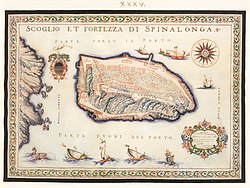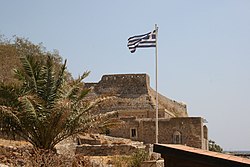Spinalonga
Native name: Σπιναλόγκα (Καλυδών) | ||
|---|---|---|
Region Crete | | |
| Regional unit | Lasithi | |
| Demographics | ||
| Population | 0 (2001) | |
Spinalonga (Greek: Σπιναλόγκα) is an island located in the Gulf of Elounda in north-eastern Crete, in the municipality of Agios Nikolaos, Lasithi, next to the town of Plaka. The island is further assigned to the area of Kalydon. It is near the
During
Origin of the name

According to Venetian documents, the name of the island originated in the Greek expression στην Ελούντα stin Elounda (meaning "to Elounda"). The Venetians could not understand the expression, so they familiarized it using their own language, and called it spina "thorn" longa "long", an expression that was also maintained by the locals.[1] The Venetians were inspired for this expression by the name of an island near Venice called by the same name and which is known today as the island of Giudecca.[citation needed]
History
Because of its position, the island was fortified from its earliest years in order to protect the entranceway of the port of Ancient Olous.[citation needed]
Arab raids
Olous, and accordingly the wider region, were depopulated at the middle of the 7th century because of the raids of the Arab pirates in the Mediterranean. Olous remained deserted until the mid-15th century, when the Venetians began to construct salt-pans in the shallow and salty waters of the gulf. Subsequently, the region acquired commercial value and became inhabited. This, in combination with the emergent Turkish threat, particularly after the Fall of Constantinople in 1453, and the continuous pirate raids, forced the Venetians to fortify the island.[citation needed]
Venetian rule

In 1578 the
In 1584, the Venetians, realising that the coastal fortifications were easy to conquer by the enemies attacking from the nearby hills, decided to strengthen their defense by constructing new fortifications at the top of the hill. The new Venetian firepower had longer range, rendering Spinalonga an impregnable sea fortress, one of the most important in the Mediterranean basin.[citation needed]
Spinalonga, along with

Ottoman rule
In 1715, the Ottoman Turks captured Spinalonga, taking over the last remaining Venetian fortress and removing the last trace of Venetian military presence from the island of Crete.[4]
Cretan revolt
At the end of the Ottoman occupation the island, together with the fort at
20th-century leper colony


The island was used as a
However, once on the island they received food, water, medical attention and social security payments. Previously, such amenities had been unavailable to Crete's leprosy patients, as they mostly lived in the area's caves, away from civilization.[citation needed]
After the leper colony was dissolved, Spinalonga sank into oblivion. Interest in it was revived by the work of people like Maurice Born.[7]
Spinalonga was one of the last active leper colonies in Europe. Others that have survived include Tichilești,_Tulcea in eastern Romania, Fontilles in Spain and Talsi in Latvia. As of 2002, few lazarettos remain in Europe.[8]
Spinalonga today

Today, the uninhabited island is a popular tourist attraction in Crete. In addition to the abandoned leper colony and the fortress, Spinalonga is known for its small pebble beaches and shallow waters. The island can easily be accessed from Plaka, Elounda and Agios Nikolaos. Tourist boats depart from all three towns on a daily basis, every 30 minutes from Elounda. Since there is no accommodation on Spinalonga, the tours last only a few hours.[citation needed]
Spinalonga is under consideration to become a World Heritage Site.[9][10]
In popular culture

L'Ordre, released in 1973, is a documentary by Jean-Daniel Pollet that focuses on the abandoned leper colony, and in particular of the colony's articulate and compelling leader, Raimondakis. Spinalonga featured in the 1977 British television series Who Pays the Ferryman? and Werner Herzog's experimental short film Last Words.
It is the (unnamed) setting of Ali Smith's short story The Touching of Wood (in
The short story "Spinalonga" by John Ware, about a tourist group that visits the island, was included in the 13th
References
- ^ "Πανδέκτης: Spinalogka -- Kalydon". pandektis.ekt.gr. Retrieved 22 August 2022.
- ^ Maltezou, Crete under Venetian rule, p. 159
- ^ Detorakis, Turkish rule in Crete, p. 343
- ^ Detorakis, Turkish rule in Crete, p. 338
- ^ Detorakis, Turkish rule in Crete, p. 385
- ^ Detorakis, Turkish rule in Crete, p. 406
- ^ Remoundakis and Born, Vies et Morts d'un Crétois lépreux.
- ^ "Peel Island". GNT History. Retrieved 27 March 2005.
- ^ Lekakis (2017). "The Spinalonga blues". Archaeology Wiki. Retrieved 9 October 2019.
- ^ "Fortress of Spinalonga". UNESCO World Heritage Centre. 16 January 2014. Retrieved 8 February 2020.
- ^ Mega takes on ‘The Island’
- ^ "The Pan Books of Horror Stories". Den of Geek. Dennis Publishing. 24 July 2008. Retrieved 28 March 2010.
Sources
- Maltezou, Chrysa A. (1988). "Η Κρήτη κατα τη Βενετοκρατία ("Crete under Venetian rule")". In Panagiotakis, Nikolaos M. (ed.). Crete, History and Civilization (in Greek). Vol. II. Vikelea Library, Association of Regional Associations of Regional Municipalities. pp. 105–162.
- Detorakis, Theocharis (1988). "Η Τουρκοκρατία στην Κρήτη ("Turkish rule in Crete")". In Panagiotakis, Nikolaos M. (ed.). Crete, History and Civilization (in Greek). Vol. II. Vikelea Library, Association of Regional Associations of Regional Municipalities. pp. 333–436.
- Remoundakis, Epaminondas; Born, Maurice (2015). Vies et Morts d'un Crétois lépreux. Toulouse: Éditions Anacharsis. ISBN 9791027901715.
- Hislop, Victoria (2005). The Island. Headline Review. ISBN 9780755309511.
- Hislop, Victoria (2008). La Isla. Spain: Nabla Ediciones. ISBN 978-84-92461-00-4.
- Zorbas, Victor. Spinalonga, The Isle of the Damned.
- Spinalonga-Paradise or Purgatory? (1986) by Beryl Darby. The Star, 46,1,6–16, (The only one reference concerning the Spinalonga leprosy colony.)
- Lekakis, Stelios (2017). "The Spinalonga Blues; notes from the field". Archaeology & Arts (online edition, archaeology.wiki)
External links
- Crete without the gods (1935). Extract "Spinalonga" on Vimeo
- Fortezza di Spina Longa and Porto di Spina Longa maps by Marco Boschini
- Werner Herzog's documentary about man from Spinalonga
- Spinalonga
